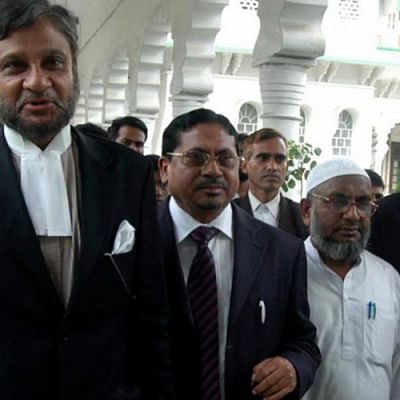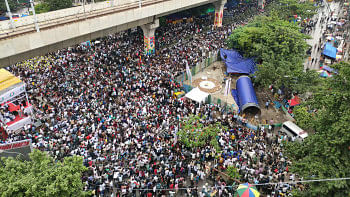Jamaat at the core

This story was first published on May 10, 2013 at http://thedailystar.net
The judgment in the war crimes trial of Jamaat-e-Islami leader Kamaruzzaman yesterday widely discussed the role of his party in organising the collaborating forces during the Liberation War, 1971.
The Jamaat, a religion-based political party and brainchild of controversial Islamist thinker Maulana Maududi, was significantly pro-active in its mission to wipe out the Bangalee nation in the name of shielding Pakistan in collaboration with the Pakistan occupation army.
International Crimes Tribunal-2, which handed down the death sentence to Kamaruzzaman yesterday for crimes committed against humanity in 1971, also said the party was behind the formation of Al-Badr, the force infamous for planning the killing of Bangalee intellectuals.
"In continuation of the earlier segment of this judgment which relates to the 'brief historical background' we deem it indispensable to get a scenario on the role and stand of the Jamaat-e-Islami in 1971, particularly when it has already been established that the Al-Badr was an 'action section', 'armed wing' of Jamaat and the Al-Badr was formed mainly of the workers of its student wing Islami Chhatra Sangha [ICS-now Islami Chhatra Shibir].
"Besides, the victims and sufferers of the diabolical atrocities do have the right to know the role the Jamaat-e-Islami played in 1971," said the tribunal, comprised of Justice Obaidul Hassan, Justice Md Mozibur Rahman Miah and Judge Md Shahinur Islam.
The three-member tribunal also cited excerpts from the book, "Sunset at Midday", written by Mohi Uddin Chowdhury, who was a leader of the Peace Committee, another organisation of collaborators, in Noakhali in 1971.
"To face the situation, the Razakar Force, consisting of pro-Pakistani elements, was formed. This was the first experiment in East Pakistan, which was a successful experiment. Following this strategy Razakar Force was being organized through out East Pakistan. This force was later on named Al-Badr and Al-Shams and Al-Mujahid."
"The workers belonging to purely Islami Chhatra Sangha were called Al-Badr, the general public belonging to the Jamaat-e-Islami, Muslim League, Nizam-e-Islami, etc., were called Al-Shams and the Urdu-speaking, generally known as Biharis, were called al-Mujahid."
Another book titled "Muktijudhdhe Dhaka 1971" notes that the Jamaat had obtained government recognition and approval for forming armed para-military groups like Razakar and Al-Badr to provide support and assistance to the Pakistan military.
Citing excerpts from Hussain Haqqani's book, "Pakistan: Between Mosque and Military", the tribunal said, "The Jamaat-e-Islami and especially its student wing, the Islami Jamiat-e-Talaba [IJT], joined the military's effort in May 1971 to launch two paramilitary counterinsurgency units."
"The IJT provided a large number of recruits….The two special brigades of Islamists cadres were named Al-Shams [the sun, in Arabic] and Al-Badr [the moon]….A separate Razakars Directorate was established……..Two separate wings called Al-Badr and Al-Shams were recognised.
"Well educated and properly motivated students from schools and madrasas were put in Al-Badr wing, where they were trained to undertake specialised operations… the remainder were grouped together under Al-Shams…"
"Bangladeshi scholars accused the Al-Badr and Al-Shams militias of being fanatical. They allegedly acted as the Pakistan army's death squads and exterminated leading left wing professors, journalists, litterateurs, and even doctors."
Hussain Haqqani served as adviser to Pakistani Prime Ministers Ghulam Mustafa Jatoi, Nawaz Sharif and Benazir Bhutto. He also served as Pakistan's ambassador to Sri Lanka from 1992 to 1993. Till recently he was Pakistan's ambassador to the United States.
A report of Fox Butterfield, published in The New York Times on January 3, 1972, establishes that the Al-Badr was being directed by a special group of Pakistani army officers.
There were a series of cryptic references to Al-Badr in papers found in the desk of Maj Gen Rao Farman Ali, the military adviser to the governor of East Pakistan, the report said.
JAMAAT AND PEACE COMMITTEE
The verdict also shed light on the link between the Jamaat and the Peace Committee.
A report published in daily Sangram on April 17, 1971 said a Peace Committee delegation, including Professor Ghulam Azam [the then ameer of Jamaat], in a meeting with East Pakistan governor Lt General Tikka Khan expressed solidarity and their adherence to the Pakistan army.
Also, Seyyed Vali Reza Nasr, in his book, "The Vanguard of the Islamic Revolution: The Jama'at-i Islami of Pakistan", wrote: "In September 1971 the alliance between the Jama'at and the army was made official when four members of the Jama'at-e-Islami of East Pakistan joined the military government of the province. Both sides saw gains to be made from their alliance."
The Jamaat, together with other religion-based political parties, had endorsed the plan of the Pakistan military in annihilating the Bangalee nation.
To support the Pakistan army further, the Jamaat backed the formation of the Peace Committee in 1971. It was also revealed in a dispatch from Sydney H Schanberg, New Delhi correspondent of The New York Times, who was expelled from East Pakistan on June 30, 1971.
"Throughout East Pakistan the army is training new para-military home guards or simply arming 'loyal' civilians, some of whom are formed into peace committees. Besides Biharis and other non-Bengali, Urdu-speaking Moslems, the recruits include the small minority of Bengali Moslems who have long supported the army — adherents of the right-wing religious parties such as the Moslem League and Jamaat-e-Islami," the judgment said, citing the dispatch.
A report of The Economist in July 1, 2010 said, "Bangladesh, formerly East Pakistan, became independent in December 1971 after a nine-month war against West Pakistan. The West's army had the support of many of East Pakistan's Islamist parties. They included Jamaat-e-Islami, still Bangladesh's largest Islamist party, which has a student wing that manned a pro-army paramilitary body, called Al Badr."
Therefore, the tribunal said, it is now history based on old authoritative documents. It was chiefly the Jamaat-e-Islami which played s pivotal role in the formation of Al-Badr, Razakar, Al-Shams and Peace Committee and of course not with any intent of guarding civilians and their property.
Rather, it is undisputed history too that those para-militia forces actively collaborated with the occupation armed forces to the accomplishment of their barbaric atrocities directed against the unarmed Bangalee civilians in the territory of Bangladesh in 1971.

 For all latest news, follow The Daily Star's Google News channel.
For all latest news, follow The Daily Star's Google News channel. 



Comments